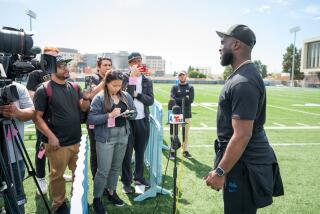Ex-coach faces a reckoning
- Share via
In a city known for gangs, corruption and poor schools, Coach Russell Otis stood for excellence and opportunity.
Over two decades, Otis led the basketball team at Dominguez High School in Compton to five state titles and a top national ranking. He helped dozens of players win college scholarships and saw four make it to the NBA. In 2000, USA Today named him high school basketball coach of the year.
These days, the 47-year-old Otis is not to be found at the Dominguez gym, getting ready for another season. Instead, he is preparing to stand trial on charges that he tried to pay one of his players for sex and stole $15,000 in Nike Inc. sponsorship money intended for the team. He has pleaded not guilty.
An examination of Otis’ career reveals a charismatic figure whose dazzling success seems to have silenced doubts about his methods.
From courtroom testimony and interviews with former players, a portrait emerges of a coach who embodied both the most inspiring and the most distressing aspects of high school sports. He ran his program like a fief, with little oversight by school district officials or California’s governing body for high school athletics.
Time and again, he coaxed elite players from other school districts to transfer to Dominguez, sometimes from across the country, according to testimony and interviews. The California Interscholastic Federation bars recruiting.
Former players have testified that Otis rewarded them with cash, gifts and favors: basketball shoes, cellphone minutes and the use of his Cadillac Escalade. The CIF prohibits coaches from using inducements to attract or retain athletes.
Yet even as he courted controversy and occasional scandal, Otis commanded the loyalty and affection of his players, many of whom describe him as a master teacher and motivator and as a father figure for boys who lacked one.
The current criminal case marks the second time Otis has been charged with a sexual offense against one of his players. In 2001, he was accused of sodomizing a member of the basketball team. He was acquitted after a three-week trial.
The Compton Unified School District, which had fired Otis, rehired him after the acquittal -- but without reviewing testimony from the trial or independently investigating the coach’s conduct, board members acknowledge.
Otis went on to coach the Dominguez Dons for six more seasons. He was fired again this May after the latest charges were filed.
At the earlier trial, former players described Otis’ recruiting and said he was generous with money, clothes and other gifts.
One player spent weeknights at the coach’s Carson town house for more than a year so he wouldn’t have to commute to school from his home in Van Nuys, according to trial testimony. The player, star guard Steve Moore, testified that Otis never acted inappropriately toward him.
But four witnesses at the trial accused the coach of molesting them or soliciting sex.
Assemblyman Isadore Hall III (D-Compton) was president of the Compton Unified school board and part of the majority that reinstated Otis in 2002. Hall now says he wishes he had known what surfaced during the trial.
“Knowing what we know now, would we change our decision if we had a chance to? Absolutely,” he said in an interview.
James Staunton, commissioner of the CIF’s Southern Section, said he too was unaware of trial testimony about Otis’ recruiting practices and other activities until Times reporters recently asked him to comment on them.
Staunton said his organization would investigate and could impose sanctions as severe as stripping Dominguez of one or more of its titles.
He said that for a high school coach to recruit talent from around the country, loan his luxury SUV to players and allow one to live at his house would be “egregious” violations of CIF bylaws.
“If this is true, it’s utter disregard for our bylaws and what we’re trying to do to keep sports community-centered and academics-based,” Staunton said.
Otis declined to comment, except for a brief conversation in a courtroom hallway in which he denied stealing the Nike sponsorship money. His attorney, Leonard Levine, said Otis never acted inappropriately with any players.
Levine said Otis’ latest accuser fabricated his story of a sexual advance because he wasn’t getting sufficient playing time and wanted an excuse to transfer to another school -- a defense Levine also presented at the 2001 trial.
“The evidence is simply not there,” Levine said.
Regarding the potential CIF violations, Levine denied that Otis gave any of his players cash but acknowledged that he had lent his Escalade to players and allowed Moore to live at his house.
“I don’t think he did anything wrong,” Levine said. “He would open his door to somebody who had no place to stay. . . . I could care less what the CIF thinks. He should be given a medal, not criticized.”
--
School takes pride in basketball team
Dominguez High School, a collection of single-story brick buildings just west of the 710 Freeway, is one of California’s poorest-performing high schools. More than half of its students drop out before graduating. So the basketball program has long been a sorely needed source of pride.
Otis was raised in Compton and played for Dominguez, earning a scholarship to Southern Utah State. In 1986, he returned as a health teacher and basketball coach.
Otis emphasized a suffocating, turnover-inducing defense, and in 1989 Dominguez won its first Southern Section championship. Seven years later, the Dons routed Northgate High School in Walnut Creek to win the first of five state championships under Otis.
“His knowledge of the game was ahead of the curve. We had the guys, and he had a plan and the dynasty started,” said Styron Ducreay, a member of the 1989 team.
By the mid-1990s, Nike was giving the school $15,000 a year to travel to play the best teams in the country. Nike outfitted the Dons in pro-style uniforms, warmups and top-of-the-line shoes.
In 2000, the team defeated Newark Memorial High School for another state title. Afterward, the players circled Compton in stretch limousines, waving to a roaring crowd.
About six months later, a 17-year-old reserve guard confided to family members that Otis had molested him, according to the boy’s testimony at the 2001 trial.
On the stand, the boy said he had transferred to Dominguez from Jordan High School in Long Beach with Otis’ encouragement. He said Otis recommended that he take a Spanish class at Compton College to replace a poor grade he had received at Jordan.
“He said . . . he knows the teacher and I wouldn’t have to show up,” the boy testified. Ultimately, the boy said, he did not take the class.
The teenager testified that Otis gave him clothes and cash -- $200 on one occasion -- and offered to buy him a car.
The boy described two sexual incidents. In the first, Otis drove him to his Carson town house, invited him to his bedroom and fondled him, the boy testified. A few weeks later, again at the town house, Otis performed oral sex on him and then sodomized him, the boy testified.
Levine, who represented Otis at the trial, pointed out inconsistencies in the boy’s account. The boy insisted that he did not go to a football game with Otis soon after the alleged assault, although video showed them together at the game.
Levine also noted that there was no medical evidence supporting the teenager’s claim that he had been anally penetrated.
Under oath, three other former students described encounters with Otis.
One of the witnesses, who had transferred from Lynwood High School, said his family was poor and Otis made things easier by giving him basketball shoes, shorts and T-shirts and driving him home after practice. The former player testified that Otis molested him in the car several times.
Another former student said the coach once stroked his legs and made suggestive comments. A third testified that Otis once offered to perform oral sex on him
Otis was not charged in any of those incidents, which allegedly happened years earlier. Prosecutors offered the testimony as evidence of a pattern of conduct.
In court, Levine highlighted inconsistencies in the three witnesses’ accounts. He pointed out that one of them described an encounter with Otis from the late 1980s that allegedly occurred in the coach’s Torrance apartment; Otis lived in Carson at the time.
“Did I believe any of them? No,” Levine said in an interview. “Did the jury believe any of them? No.”
The jury acquitted Otis of all charges after deliberating less than a day.
Another former Dominguez player, who did not testify at the trial, told The Times recently that Otis had touched him in a way that made him uncomfortable.
DiJon Bernard, a member of the 1989 Southern Section championship team, said Otis was driving him home from a practice and stopped outside a convenience store. Bernard said the coach put his hand on Bernard’s thigh -- “long enough for me to be like, ‘Hey, whoa.’ ”
Bernard gave this account to a Times reporter who had contacted him and other former Dominguez players to ask about their experiences playing for Otis. Bernard, now 39 and a security guard, said he never reported the alleged incident to authorities.
“I’ve been waiting 10 years for someone to come here and ask these questions,” he said.
During a brief courthouse conversation, Otis dismissed the allegation, saying Bernard would have rebuffed any such overture with physical force.
Levine said Bernard blamed Otis for his own failure to win a college scholarship.
“This is his way of getting back,” Levine said.
--
Star players are key to dominance
Stephen Burns, a point guard for Dominguez in the early 1990s, wasn’t from Compton. He wasn’t even from California. Burns was from Fort Smith, Ark. In an interview, he explained why he moved across the country to play for Otis.
Burns said he was in Southern California for a family reunion when the coach’s brother, Donald, saw him play in a pickup basketball game. Burns is related to the brother by marriage, but said he had never met him before.
He said Donald Otis suggested to his parents that the boy move in with him and play for Dominguez. Burns and a Fort Smith teammate ended up relocating together.
“If I’m on that roster, in that gym, I have an opportunity to go to college too,” said Burns, who now coaches women’s basketball in South Carolina.
He said he had only positive experiences at Dominguez and was glad he had transferred.
Efforts to reach Donald Otis for comment were unsuccessful.
Aggressive recruiting of star players, wherever they might live, was key to the Dons’ dominance.
Steve Moore, the star shooting guard, transferred to Dominguez from Santa Monica High School. At Otis’ 2001 trial, Moore testified that after his mother moved to Van Nuys, he had trouble getting to school in the morning, and Otis agreed to let him stay at his town house on weeknights.
Moore, a key member of the 1999 and 2000 state championship teams, testified that the arrangement started late in his junior year and continued through his senior season. He said Otis acted like a father, setting curfews and rules about homework, and that he never acted inappropriately.
When the high school prom rolled around, the coach gave him the keys to his Escalade so he could impress his date, Moore said.
CIF bylaws bar coaches from using gifts, favors or other inducements to attract or retain players. Asked whether Moore’s living arrangement violated the bylaws, Staunton, the CIF commissioner, said: “Oh my God, yes! He would’ve been declared ineligible.”
Mingus Murray was an eighth-grader in New York City when, he said, a friend of Otis’ saw him shooting baskets at a public court in 1999. Murray said the man approached his mother and suggested that the boy move to Southern California to play for the Dons.
Murray said moving was easy because his mother owned a home in Studio City, but commuting to Compton every morning was an ordeal.
“I wouldn’t trade it for anything. I loved playing for Coach Otis,” said Murray, who was a reserve point guard for the 2000 state championship team and is now a professional guitarist.
“I remember him saying, ‘Every day you don’t improve, you’re not getting better. You’re getting worse.’ He’s a great teacher. I don’t know about his personal life.”
--
Coach reinstated by school board
In 2001-02, with Otis out of the picture, former Lakers player Mack Calvin coached the Dons to a 15-12 record, their worst in years. Calvin resigned at the end of the season.
Otis then applied for his old job, and the school board reinstated him on a 4-3 vote.
“He was a good coach,” said Marjorie Shipp, now the board president, who voted with the majority. “The kids respected him, and the parents respected him. And [the jury] didn’t find anything on him.”
Then-board member Erica Quijada-Barrera, a social worker, voted no. But, she said, Otis was “a hero” to the community and the desire to restore the basketball program’s luster -- to “let us succeed again” -- carried the day.
During Otis’ second stint, Dominguez won another state championship and three more Southern Section titles.
Then, in September 2008, a 16-year-old player told sheriff’s deputies that Otis sent him suggestive text messages and offered him $1,500 if he would allow the coach to perform oral sex on him.
In March, prosecutors charged Otis with meeting a minor for a lewd purpose, a felony; and child annoyance, a misdemeanor.
Otis is also charged with grand theft and forgery for allegedly depositing in his bank account a $15,000 check from Nike payable to the school district. He is accused of using a forged letter to make it appear that he had the high school principal’s permission to deposit the check.
The school district fired Otis in May, citing the alleged theft in a termination letter but not the alleged sexual offense. He is appealing the firing.
Otis said he had the principal’s permission to deposit the Nike check in his account, and Levine said his client could prove he spent “nearly every dollar” on the team.
At a preliminary hearing in the case, a school secretary testified that financial oversight of the Dominguez basketball program was weak.
She said that in 2007, Otis was reimbursed for $2,500 in expenses based on receipts marked simply “basketball reimbursement,” with no supporting documentation.
School district records obtained by The Times under the California Public Records Act show other curious transactions.
In 2005 and 2006, Otis was reimbursed $5,100 for airfare and hotel bills from team trips to Las Vegas, Florida and Indianapolis.
He submitted invoices bearing the letterhead of Emory G Group, a real estate investment firm owned by his former landlord, Sheryl Petway. Petway’s lawyer said the firm is not involved in the travel business.
“The alleged receipts for airfare and hotel and for cash are not legitimate receipts of the Emory G Group,” the lawyer, Leonardo Starke, wrote in an e-mail after reviewing the invoices.
Levine said Otis may not have paid for travel through Emory G Group. But he asserted that Otis spent $5,100 on team travel and was entitled to reimbursement.
“Who cares what the name is on that?” Levine said. “All that matters is he spent the money on that team.”
--
New era begins for basketball team
As a new season approaches, the Dons’ dominance appears to be over. Some star players have transferred to other schools.
“It’s going to be fun now, thinking we’re on a level playing field for once,” said Downey High School Coach Larry Shelton. “It sounds like they’ll be playing with kids from their neighborhood, just like the rest of us have been doing all these years.”
Not everyone welcomes the change. Alita Godwin said she “dreams” that her 15-year-old son, Juwan, a Dominguez student, will be able to play for Otis someday, like his older brother, Tyree, did.
“If he’s not convicted, people will want him back. And I hope he’ll come back,” she said. “He should win one more championship, and then walk away.”
--
Times news researchers Vicki Gallay and Scott Wilson contributed to this report.
More to Read
Get our high school sports newsletter
Prep Rally is devoted to the SoCal high school sports experience, bringing you scores, stories and a behind-the-scenes look at what makes prep sports so popular.
You may occasionally receive promotional content from the Los Angeles Times.








